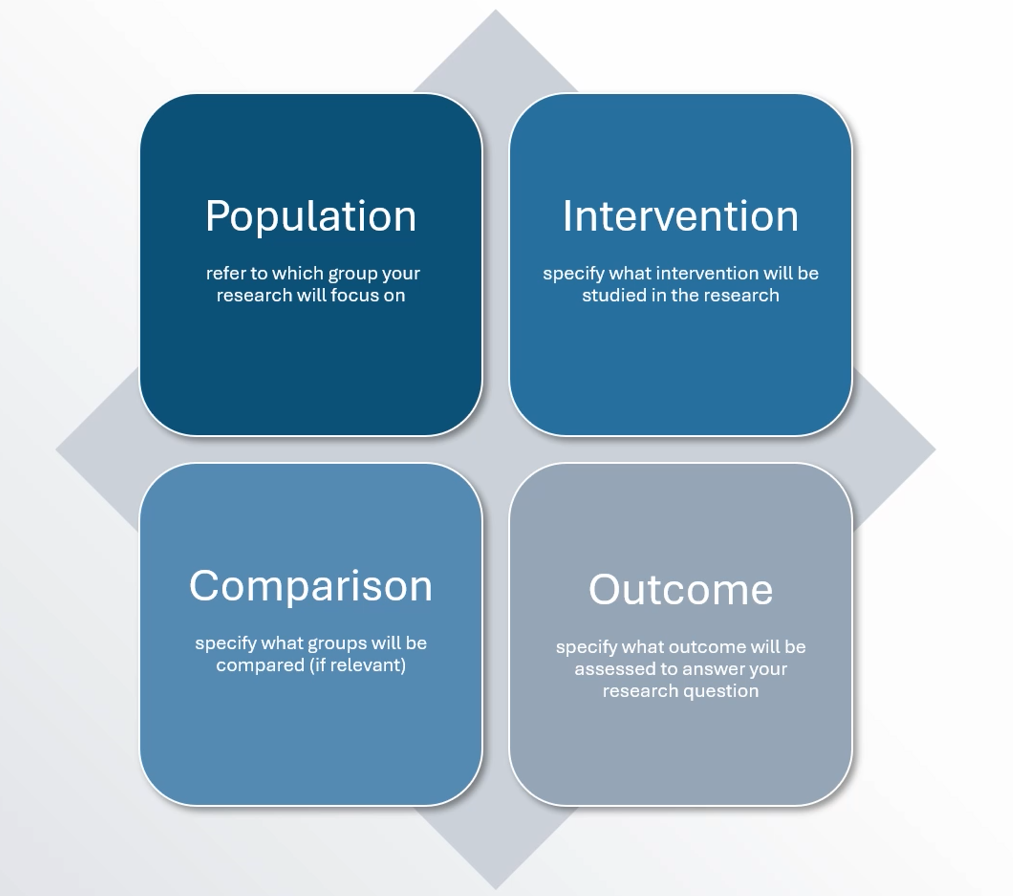Mindset XR Module 13: Research questions

Welcome to the Mindset Extended Reality (XR) Innovation Support Programme learning resources, which include three series delivered in conjunction with our expert Mindset-XR programme partners:
• Medical regulation;
• Clinical evidence;
• Lived experience involvement.
Mindset-XR is helping to catalyse the growth of immersive digital mental health solutions in the UK, through funding, tailored support and training. It is delivered by Innovate UK and the Health Innovation Network South London (HIN).
This series focuses on research and clinical evidence, with key insights from King's College London's Institute of Psychiatry, Psychology and Neuroscience. Across a number of modules, these resources will guide you through your research journey, from establishing what you plan to investigate, to conducting research and disseminating your findings.
Outline
What are research questions?
Understanding why good research questions are important for building your product and evidence base
Deciding on research questions
A step-by-step guide to building a good research question
Framing a research question correctly
Using the PICO framework to ensure that your research question is consistent with best practice
What are research questions?
In Module 12, we covered the first steps you might take in researching your innovation. These steps focused on using relatively informal techniques to decide on an initial plan for your innovation, as well as how to use a prototype of your product or service to test performance and using these insights to guide development.
This module begins the transition into more formal and in-depth evidence generation related to your innovation. Ultimately, the aim of this work will be to develop a compelling evidence base that gives you and other stakeholders (such as users or customers) confidence in the safety and effectiveness of your innovation.
Research questions help to operationalise what is you want your innovation to achieve in terms of a knowledge "problem". For example, you might want to know:
-
- • If people with dementia find a VR scenario accessible and acceptable to engage with
- • Whether exposure to a natural scene in a VR environment reduces stress in healthcare staff
- • The barriers and facilitators to implementing a VR relaxation tool for staff in NHS inpatient settings
- Settling on the right research question (or questions) will shape all your further research in terms of the methods that you use - so it is important to get right.
Deciding on research questions
Coming to your research question (or questions) should follow a methodical process. Investigating your research question is likely to take significant time and resources, so it is important not to rush your thinking and wider insight gathering.
The process can be broken down into six steps:
1. Identify your area of interest
It is likely that you will already have some idea of the area of interest based on the early stage development of your innovation, for example VR applications which alleviate anxiety or the use of technology to build social networks for people experiencing mental health challenges. If not - you should clarify the focus of your innovation before proceeding.2. Look into existing work
Existing research will help to inform your product development, as well as the research question you want to investigate; there is no sense in picking a research question where a consensus answer already exists. Conducting a systematic review or meta-analysis of research in your area will give you an in-depth view of current understanding. Depending on your commercial situation, you may wish to consider publishing these reviews to support scientific understanding of your focus area.3. Decide what you still need to know
Your review of existing scientific literature is likely to have given you robust evidence related to some aspects of your innovation. For example, you might have found good-quality evidence to support a particular theoretical model being applied to a disease area, or for the acceptability of a type of technology with a particular group. However, if your innovation is truly innovative, there are still likely to be unanswered questions.4. List questions to address the information gap
Write down several questions which address the gaps in the existing knowledge; try different phrasing or focus points to give yourself the opportunity to refine these questions later.5. Narrow down the focus of your questions
Begin to interrogate the list of possible questions and specifically how they relate to your project. Why do you want to know the answer to this question? How will it support your project?
6. Evaluate the research question or questions
Before you proceed, you should make sure that your chosen research question (or questions) satisfy all of the below criteria:
• Does it lead to a clear plan for the research• Is it focused?
• Is it interesting and useful?
• Is it feasible to investigate given the resources and time you have available to you?
• It is measureable?
Framing a research question correctly
Now that you have the basis of your research question or questions, you can begin to refine how it is presented to ensure it clearly outlines all the key parameters you want to investigate. One way of doing this is through using the PICO framework:

Through addressing each part of the framework, you can ensure that your research question is as clear and comprehensive as possible.
The population component should be as specific as you are able to make it. Will you be investigating children or adults? Inpatients or outpatients? People affected by a particular condition? You can aid this process by writing inclusion and exclusion criteria - people who definitely should (or should not) be included in your target group to research.
Moving on, the intervention component will usually refer to your product or service. You should be clear and specific on exactly what this intervention is, using a brand name if applicable.
Not all research questions will include a comparison component, which refers to a point of reference that the intervention will be tested against. This may be a comparison to people being treated using an existing therapeutic protocol, or to people who receive no intervention at all.
Finally, the outcome measure will specify how you will quantify answering your research question. For example, you could state that you will measure a reduction in anxiety using a standardised scale, or an increase in self-reported staff job satisfaction.
If your question addresses all of the PICO points, you are likely to have a robust research question ready to take into the next stage of the research process, research design.
Summary
Finding the right research question sets the basis for any successful research activity. Throughout your research project, this will act as the guiding objective for your work.
Taking the time to work through identifying possible questions and refining how your question is framed and articulated will pay dividends as you proceed through your research journey.

